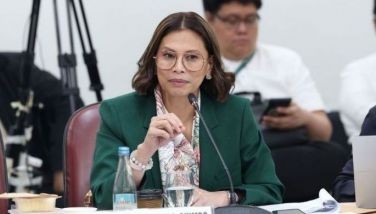Breast cancer patients getting younger, expert says
October 23, 2005 | 12:00am
Breast cancer patients are getting younger now, so every woman needs to make a habit of examining her own breasts regularly, an expert said.
Dr. Cristina Santos, president of the Philippine Foundation for Breast Care Inc. (PFBCI), said while breast cancer is more common among aging women, she is starting to see patients in their 20s who already have the disease.
"There is no explanation for this. But maybe, the stressful life and the unhealthy diet that we have now and the worsening pollution have something to do with it," she said.
Santos said the best method of fighting cancer is early detection and treating the disease at its first stages. Breast cancer can manifest itself as a persistent but painless lump in the breast or through thickening, swelling or dimpling of one or both breasts.
She added that every woman should learn how to do "breast self-examination" or BSE to detect lumps and other "warning signs" in their breasts.
BSE should be done every month, seven to 10 days from the first day of a woman’s monthly cycle if she is not menstruating, Santos said.
The PFBCI is committed to raising awareness about breast cancer and assisting patients through its Breast Care Center. The foundation recently organized an auction of paintings to generate funds for indigent patients under its care.
Records of the Philippine Cancer Society (PCS) show that since 1980, breast cancer has been the leading form of the disease among women.
Breast cancer is more identified with women but can also affect men in rare cases — one male develops breast cancer for every 105 females stricken with the disease. For every 100 females, 26 could develop breast cancer. The PCS estimates there would around 14,000 new breast cancer cases and 6,300 deaths from the illness this year.
Women nearing or in their pre-menopausal period are more prone to developing cancer because their production of estrogen increases at this time. Estrogen is a female hormone that can serve as "food" for cancer cells, Santos said.
Meanwhile, the World Health Organization (WHO) warned that around one million people in the Western Pacific region die each year from environmental health risks and this number will increase if effective countermeasures are not implemented.
The WHO said 580,000 of these deaths are attributable to "traditional" risk factors such as indoor smoke from solid fuels; unsafe water; and inadequate sanitation and hygiene.
Modern risks are responsible for another 405,000 deaths, 96 percent of which occur in the region’s developing countries. The WHO said these modern risks include urban air pollution, exposure to lead and other pollutants, industrial accidents and effects of climate change.
WHO representative for the Western Pacific Dr. Shigeru Omi said WHO member countries need to strengthen human resources and institutional capacity for environmental health risk assessment and management.
He said this concern was raised during the 56th session of the WHO regional committee for the Western Pacific. The meeting, attended by 100 representatives from various countries, discussed future health directions in the region.
Though there are international agreements to reduce environmental health risks, the committee underscored the need to develop "more systematic approaches to assessing and reducing" these risks.
The members of the committee agreed that multi-country efforts are required to address the problem since water, air and coastal pollution are transnational concerns.
Dr. Cristina Santos, president of the Philippine Foundation for Breast Care Inc. (PFBCI), said while breast cancer is more common among aging women, she is starting to see patients in their 20s who already have the disease.
"There is no explanation for this. But maybe, the stressful life and the unhealthy diet that we have now and the worsening pollution have something to do with it," she said.
Santos said the best method of fighting cancer is early detection and treating the disease at its first stages. Breast cancer can manifest itself as a persistent but painless lump in the breast or through thickening, swelling or dimpling of one or both breasts.
She added that every woman should learn how to do "breast self-examination" or BSE to detect lumps and other "warning signs" in their breasts.
BSE should be done every month, seven to 10 days from the first day of a woman’s monthly cycle if she is not menstruating, Santos said.
The PFBCI is committed to raising awareness about breast cancer and assisting patients through its Breast Care Center. The foundation recently organized an auction of paintings to generate funds for indigent patients under its care.
Records of the Philippine Cancer Society (PCS) show that since 1980, breast cancer has been the leading form of the disease among women.
Breast cancer is more identified with women but can also affect men in rare cases — one male develops breast cancer for every 105 females stricken with the disease. For every 100 females, 26 could develop breast cancer. The PCS estimates there would around 14,000 new breast cancer cases and 6,300 deaths from the illness this year.
Women nearing or in their pre-menopausal period are more prone to developing cancer because their production of estrogen increases at this time. Estrogen is a female hormone that can serve as "food" for cancer cells, Santos said.
Meanwhile, the World Health Organization (WHO) warned that around one million people in the Western Pacific region die each year from environmental health risks and this number will increase if effective countermeasures are not implemented.
The WHO said 580,000 of these deaths are attributable to "traditional" risk factors such as indoor smoke from solid fuels; unsafe water; and inadequate sanitation and hygiene.
Modern risks are responsible for another 405,000 deaths, 96 percent of which occur in the region’s developing countries. The WHO said these modern risks include urban air pollution, exposure to lead and other pollutants, industrial accidents and effects of climate change.
WHO representative for the Western Pacific Dr. Shigeru Omi said WHO member countries need to strengthen human resources and institutional capacity for environmental health risk assessment and management.
He said this concern was raised during the 56th session of the WHO regional committee for the Western Pacific. The meeting, attended by 100 representatives from various countries, discussed future health directions in the region.
Though there are international agreements to reduce environmental health risks, the committee underscored the need to develop "more systematic approaches to assessing and reducing" these risks.
The members of the committee agreed that multi-country efforts are required to address the problem since water, air and coastal pollution are transnational concerns.
BrandSpace Articles
<
>
- Latest
- Trending
Trending
Latest






























